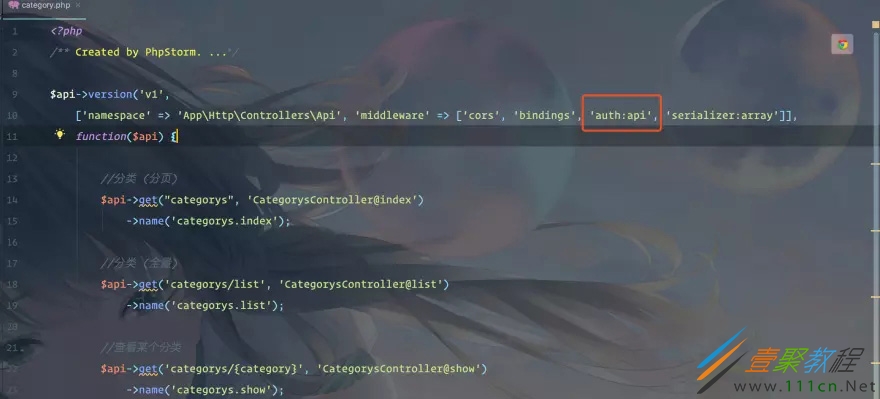最新下载
热门教程
- 1
- 2
- 3
- 4
- 5
- 6
- 7
- 8
- 9
- 10
基于Laravel Auth自定义接口API用户认证的实现方法
时间:2018-07-11 编辑:猪哥 来源:一聚教程网
基于 laravel 默认的 auth 实现 api 认证
现在微服务越来越流行了. 很多东西都拆分成独立的系统,各个系统之间没有直接的关系. 这样我们如果做用户认证肯定是统一的做一个独立的 用户认证 系统,而不是每个业务系统都要重新去写一遍用户认证相关的东西. 但是又遇到一个问题了. laravel 默认的auth 认证 是基于数据库做的,如果要微服务架构可怎么做呢?
实现代码如下:
UserProvider 接口:
// 通过唯一标示符获取认证模型 public function retrieveById($identifier); // 通过唯一标示符和 remember token 获取模型 public function retrieveByToken($identifier, $token); // 通过给定的认证模型更新 remember token public function updateRememberToken(Authenticatable $user, $token); // 通过给定的凭证获取用户,比如 email 或用户名等等 public function retrieveByCredentials(array $credentials); // 认证给定的用户和给定的凭证是否符合 public function validateCredentials(Authenticatable $user, array $credentials);
Laravel 中默认有两个 user provider : DatabaseUserProvider & EloquentUserProvider.
DatabaseUserProvider
IlluminateAuthDatabaseUserProvider
直接通过数据库表来获取认证模型.
EloquentUserProvider
IlluminateAuthEloquentUserProvider
通过 eloquent 模型来获取认证模型
根据上面的知识,可以知道要自定义一个认证很简单。
自定义 Provider
创建一个自定义的认证模型,实现 Authenticatable 接口;
AppAuthUserProvider.php
Authenticatable 接口:
IlluminateContractsAuthAuthenticatable
Authenticatable 定义了一个可以被用来认证的模型或类需要实现的接口,也就是说,如果需要用一个自定义的类来做认证,需要实现这个接口定义的方法。
Laravel 中定义的 Authenticatable trait,也是 Laravel auth 默认的 User 模型使用的 trait,这个 trait 定义了 User 模型默认认证标示符为 'id',密码字段为password,remember token 对应的字段为 remember_token 等等。
通过重写 User 模型的这些方法可以修改一些设置。
实现自定义认证模型
AppModelsUser.php
primaryKey;
}
/**
* 获取主键的值
* @return mixed
*/
public function getAuthIdentifier()
{
$id = $this->{$this->getAuthIdentifierName()};
return $id;
}
public function getAuthPassword()
{
return '';
}
public function getRememberToken()
{
return '';
}
public function setRememberToken($value)
{
return true;
}
public function getRememberTokenName()
{
return '';
}
protected static function getBaseUri()
{
return config('api-host.user');
}
public static $apiMap = [
'getUserByToken' => ['method' => 'GET', 'path' => 'login/user/token'],
'getUserByGuId' => ['method' => 'GET', 'path' => 'user/guid/:guid'],
];
/**
* 获取用户信息 (by guid)
* @param string $guid
* @return User|null
*/
public static function getUserByGuId(string $guid)
{
try {
$response = self::getItem('getUserByGuId', [
':guid' => $guid
]);
} catch (RestApiException $e) {
return null;
}
return $response;
}
/**
* 获取用户信息 (by token)
* @param string $token
* @return User|null
*/
public static function getUserByToken(string $token)
{
try {
$response = self::getItem('getUserByToken', [
'Authorization' => $token
]);
} catch (RestApiException $e) {
return null;
}
return $response;
}
}
上面 RestApiModel 是我们公司对 Guzzle 的封装,用于 php 项目各个系统之间 api 调用. 代码就不方便透漏了.
Guard 接口
IlluminateContractsAuthGuard
Guard 接口定义了某个实现了 Authenticatable (可认证的) 模型或类的认证方法以及一些常用的接口。
// 判断当前用户是否登录 public function check(); // 判断当前用户是否是游客(未登录) public function guest(); // 获取当前认证的用户 public function user(); // 获取当前认证用户的 id,严格来说不一定是 id,应该是上个模型中定义的唯一的字段名 public function id(); // 根据提供的消息认证用户 public function validate(array $credentials = []); // 设置当前用户 public function setUser(Authenticatable $user);
StatefulGuard 接口
IlluminateContractsAuthStatefulGuard
StatefulGuard 接口继承自 Guard 接口,除了 Guard 里面定义的一些基本接口外,还增加了更进一步、有状态的 Guard.
新添加的接口有这些:
// 尝试根据提供的凭证验证用户是否合法 public function attempt(array $credentials = [], $remember = false); // 一次性登录,不记录session or cookie public function once(array $credentials = []); // 登录用户,通常在验证成功后记录 session 和 cookie public function login(Authenticatable $user, $remember = false); // 使用用户 id 登录 public function loginUsingId($id, $remember = false); // 使用用户 ID 登录,但是不记录 session 和 cookie public function onceUsingId($id); // 通过 cookie 中的 remember token 自动登录 public function viaRemember(); // 登出 public function logout();
Laravel 中默认提供了 3 中 guard :RequestGuard,TokenGuard,SessionGuard.
RequestGuard
IlluminateAuthRequestGuard
RequestGuard 是一个非常简单的 guard. RequestGuard 是通过传入一个闭包来认证的。可以通过调用 Auth::viaRequest 添加一个自定义的 RequestGuard.
SessionGuard
IlluminateAuthSessionGuard
SessionGuard 是 Laravel web 认证默认的 guard.
TokenGuard
IlluminateAuthTokenGuard
TokenGuard 适用于无状态 api 认证,通过 token 认证.
实现自定义 Guard
AppAuthUserGuard.php
request = $request;
$this->provider = $provider;
$this->inputKey = 'Authorization';
$this->storageKey = 'api_token';
}
/**
* Get the currently authenticated user.
* @return IlluminateContractsAuthAuthenticatable|null
*/
public function user()
{
if(!is_null($this->user)) {
return $this->user;
}
$user = null;
$token = $this->getTokenForRequest();
if(!empty($token)) {
$user = $this->provider->retrieveByCredentials(
[$this->storageKey => $token]
);
}
return $this->user = $user;
}
/**
* Rules a user's credentials.
* @param array $credentials
* @return bool
*/
public function validate(array $credentials = [])
{
if (empty($credentials[$this->inputKey])) {
return false;
}
$credentials = [$this->storageKey => $credentials[$this->inputKey]];
$this->lastAttempted = $user = $this->provider->retrieveByCredentials($credentials);
return $this->hasValidCredentials($user, $credentials);
}
/**
* Determine if the user matches the credentials.
* @param mixed $user
* @param array $credentials
* @return bool
*/
protected function hasValidCredentials($user, $credentials)
{
return !is_null($user) && $this->provider->validateCredentials($user, $credentials);
}
/**
* Get the token for the current request.
* @return string
*/
public function getTokenForRequest()
{
$token = $this->request->header($this->inputKey);
return $token;
}
/**
* Set the current request instance.
*
* @param IlluminateHttpRequest $request
* @return $this
*/
public function setRequest(Request $request)
{
$this->request = $request;
return $this;
}
}
在 AppServiceProvider 的 boot 方法添加如下代码:
AppProvidersAuthServiceProvider.php
token provider.
Auth::provider('token', function() {
return app(UserProvider::class);
});
// auth:api -> token guard.
// @throw Exception
Auth::extend('token', function($app, $name, array $config) {
if($name === 'api') {
return app()->make(UserGuard::class, [
'provider' => Auth::createUserProvider($config['provider']),
'request' => $app->request,
]);
}
throw new Exception('This guard only serves "auth:api".');
});
.
.
.
在 configauth.php的 guards 数组中添加自定义 guard,一个自定义 guard 包括两部分: driver 和 provider.
设置 configauth.php 的 defaults.guard 为 api.
[ 'guard' => 'api', 'passwords' => 'users', ], /* |-------------------------------------------------------------------------- | Authentication Guards |-------------------------------------------------------------------------- | | Next, you may define every authentication guard for your application. | Of course, a great default configuration has been defined for you | here which uses session storage and the Eloquent user provider. | | All authentication drivers have a user provider. This defines how the | users are actually retrieved out of your database or other storage | mechanisms used by this application to persist your user's data. | | Supported: "session", "token" | */ 'guards' => [ 'web' => [ 'driver' => 'session', 'provider' => 'users', ], 'api' => [ 'driver' => 'token', 'provider' => 'token', ], ], /* |-------------------------------------------------------------------------- | User Providers |-------------------------------------------------------------------------- | | All authentication drivers have a user provider. This defines how the | users are actually retrieved out of your database or other storage | mechanisms used by this application to persist your user's data. | | If you have multiple user tables or models you may configure multiple | sources which represent each model / table. These sources may then | be assigned to any extra authentication guards you have defined. | | Supported: "database", "eloquent" | */ 'providers' => [ 'users' => [ 'driver' => 'eloquent', 'model' => AppModelsUser::class, ], 'token' => [ 'driver' => 'token', 'model' => AppModelsUser::class, ], ], /* |-------------------------------------------------------------------------- | Resetting Passwords |-------------------------------------------------------------------------- | | You may specify multiple password reset configurations if you have more | than one user table or model in the application and you want to have | separate password reset settings based on the specific user types. | | The expire time is the number of minutes that the reset token should be | considered valid. This security feature keeps tokens short-lived so | they have less time to be guessed. You may change this as needed. | */ 'passwords' => [ 'users' => [ 'provider' => 'users', 'table' => 'password_resets', 'expire' => 60, ], ], ];
使用 方式:
参考文章:地址
相关文章
- Golang ProtoBuf的基本语法详解 10-20
- Python识别MySQL中的冗余索引解析 10-20
- Python+Pygame绘制小球代码展示 10-18
- Python中的数据精度问题介绍 10-18
- Python随机值生成的常用方法介绍 10-18
- python3解压缩.gz文件分析 09-27















